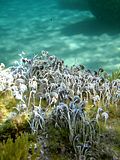Rhizoids are protuberances that extend from the lower epidermal cells of bryophytes and algae. They are similar in structure and function to the root hairs...
4 KB (434 words) - 08:01, 21 May 2023
the pigment anthocyanin. Rhizoids are nearly lacking in aquatic forms, but there are usually numerous unicellular rhizoids of two types on the ventral...
5 KB (518 words) - 03:04, 19 May 2024
centimetres (1.6 to 3.9 in) tall and has three anatomical parts: a bottom rhizoid that resembles a set of short roots; a long stalk in the middle; and a...
18 KB (2,054 words) - 21:38, 14 March 2024
the last group, rhizoids of compatible strains meet and fuse. Both nuclei migrate out of the zoosporangium and into the conjoined rhizoids where they fuse...
30 KB (2,803 words) - 19:58, 26 April 2024
Storage organs Vascular tissue Vascular bundle Wood Vegetative Bulb Root Rhizoid Rhizome Shoot Bud Leaf Cataphyll Petiole Sessility Stem Reproductive (incl...
109 KB (11,571 words) - 02:57, 24 May 2024
casts preserved. Further, the fossil gets narrower as it attaches to a rhizoid, a place where one would expect there to be the highest concentration of...
9 KB (861 words) - 14:37, 21 May 2024
2 – Central cavity 3 – Internal wall 4 – Pore (all the walls and septa have pores, not all are represented) 5 – Septum 6 – External wall 7 – Rhizoid...
11 KB (1,157 words) - 19:55, 7 May 2024
not-for-profit arts organization All pages with titles containing Rhizome Rhizoid, protuberances that extend from the lower epidermal cells of bryophytes...
642 bytes (124 words) - 10:15, 7 March 2021
to the soft seafloor using a rhizoid, a root-like structure that embeds into the sea floor. From the top of the rhizoid, 1 to 6 horizontal, equidistant...
7 KB (827 words) - 18:58, 17 January 2024
Flavobacterium. The name derives from the way in which the organism grows in rhizoid columnar formations. The species was first described by Davis (1922), and...
3 KB (277 words) - 22:23, 3 December 2023








